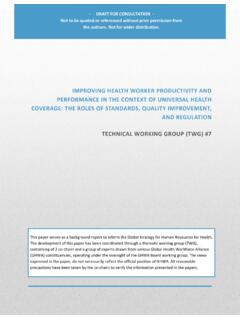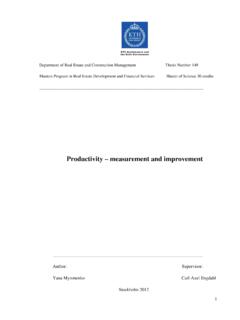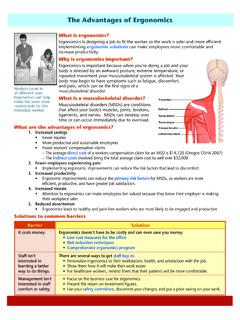Transcription of Farming Transformation Fund Improving Farm Productivity ...
1 Farming Transformation Fund Improving Farm Productivity grant manual 2 Contents About the Farming Investment Fund and Farming Transformation Fund .. 3 About the Improving Farm Productivity grant .. 5 How the Improving Farm Productivity grants work .. 7 Eligible and ineligible items .. 9 How to apply .. 15 What is required to complete a full application .. 18 If you are offered a grant .. 22 If your application is unsuccessful .. 22 Northern Ireland .. 23 Contact details .. 23 Annex 1: Robotic equipment definitions and requirements .. 24 Annex 2: Additional slurry equipment under the Farming Equipment & Technology Fund .. 31 3 The Farming Transformation Fund provides grants for eligible beneficiaries to invest in their businesses to improve Productivity , profitability, and enhance environmental sustainability.
2 This manual is about the Farming Transformation Fund Improving Farm Productivity grant. It explains what the grant is for, who is eligible and how to apply. About the Farming Investment Fund and Farming Transformation Fund The Farming Investment Fund (FIF) is part of the prosperity and Productivity funding in England's Agricultural Transition Offer. It is a new initiative to support the industry to increase Productivity in an environmentally sustainable way. It is based on the Countryside Productivity Grant scheme. The Farming Investment Fund is divided into 2 schemes. Farming Equipment & Technology Fund (FETF) provides smaller grants to improve business performance. Farming Transformation Fund (FTF) supports larger investments. The Farming Transformation Fund provides grants for eligible beneficiaries to invest in their businesses to improve Productivity , profitability and enhance environmental sustainability.
3 There are 3 themes: Water Management Improving Farm Productivity 4 Added Value. This manual is about the Farming Transformation Fund - Improving Farm Productivity grant. It explains what the grant is for, who is eligible and how to apply. How the government manages these grants The Rural Payments Agency (RPA) delivers the grants. RPA s role is to assess applications for grants and make offers for grant funding on behalf of the Department for Environment, Food & Rural Affairs (Defra). RPA may at any time and without further notice change the date these grants close to applications. 5 About the Improving Farm Productivity grant What you can and cannot get a grant for, what we are looking for, and what the priorities are. What the grants are for These grants are for capital items to improve farm and horticulture Productivity through: the use of robotic or autonomous equipment and systems to aid crop and livestock production the installation of slurry acidification equipment (improved nutrient management, reduced ammonia emissions).
4 You can find a full list of capital items that are eligible for this scheme in the Eligible costs section. What the grants are not for The grants cannot be used to: generate renewable energy (grants may be available through Business, Energy and Industrial Strategy) buy irrigation equipment (grants available through FETF or FTF Water management) fund equipment used in the processing and packing of fruit or vegetables (grants may be available in future FTF Adding Value scheme, details to be announced in a few months) fund crop storage (grants may be available in future FTF Adding Value scheme) fund anaerobic digesters (grants may be available through Business, Energy and Industrial Strategy). 6 You can find a full list of costs which are not eligible for this scheme in the Costs which are not eligible section.
5 Priorities for funding The priorities are to: improve Productivity improve the environment introduce innovation. What we are looking for We are looking for projects that improve farm Productivity through: Improving efficiency and effectiveness of primary agricultural or horticultural production reducing your farms environmental impact resulting in a positive contribution to net zero and GHG reduction Improving nutrient and resource management that supports optimisation of field and livestock operations adoption of automation in areas where access to labour is an issue. 7 How the Improving Farm Productivity grants work Who can and cannot apply, how much can you get and what can you buy. Who can apply Farmers and horticulturalists in England can apply for the Improving farm Productivity grants.
6 You need to own the land on which these activities take place, or you need to have a tenancy agreement in place until 5 years after the project has been completed. Contractors can also apply if they have a registered business address in England. Contractors are defined as a business (including a sole trader) that carries out an agricultural or horticultural activity as a service. Who cannot apply The following are not eligible for the grants: public organisations, including Crown bodies and non-departmental public bodies (NDPBs) local authorities members of Producer Organisations under the Fresh Fruit and Vegetables Aid Scheme if they have funding for the same project through their operational programme forestry businesses. How much money you can apply for The minimum grant you can claim is 35,000 (40% of 87,500).
7 The maximum grant available under the Improving Farm Productivity theme is 500,000 per applicant. If you want to apply for both a slurry project and a robotics project, you need to submit 2 separate applications. The maximum grant amount for both projects is 500,000 in total. 8 At least 60% of the project costs need to be paid for with money from private sources like savings or a bank loan. You need to be able to pay the remaining project costs. You can use loans, overdrafts and certain other grants, such as the Basic Payment Scheme or agri-environment schemes such as the Countryside Stewardship scheme. You cannot use other public money (for example grant funding from local authorities) towards the project costs. You cannot use this grant to carry out capital works which are required under other agreements.
8 Paying for the project Grants are paid in arrears. You can only claim after the work being claimed for is finished and has been paid for. We expect you to make a maximum of 3 claims over the course of the project. If you buy an item for the project using lease purchase or hire purchase, you need to own this outright before you can claim any grant money towards it. This means that, before you claim the grant, you need to: pay all of the instalments show that the title has passed to you. Otherwise, you will not be able to include these costs in your claim. You should not start work or commit to any costs (including paying deposits), enter into any legal contracts, or place an order before the project start date in your Grant Funding Agreement. Any costs incurred before that date are at your own risk and may make your whole project ineligible.
9 9 Eligible and ineligible items What you can and cannot buy. Eligible items The grant can be used to pay for the following: Robotics and innovation For the purposes of this scheme robotics is defined as autonomous equipment which performs all 4 of the following functions in a continuous loop: sensing the environment in which it operates understanding its environment from what it has sensed planning what it needs to do from what it has understood controlling the operation/process it has decided needs to be done (including controlling of actuators which may or may not be part of the eligible project costs). The list of eligible items is as follows: robotic harvesting equipment robotic weeding equipment robotic spraying equipment autonomous driverless tractors or platforms voluntary robotic milking system robotic feeding systems robotic transplanting advanced ventilation control units 10 wavelength specific LED lighting for horticultural crops.
10 Other autonomous robotic technology that is not included in the list above will also be considered. For this equipment to be considered eligible it needs to have all the following: a sensing system ability to understand its environment decision making capability to plan control actuators (the devices that move robot joints). If your online application is for other autonomous robotic technology we will assess whether it is eligible before the project is invited to apply for a full application. Fossil fuel powered equipment Reducing environmental impacts is a key aim of the scheme. Therefore, robotic equipment utilising an electric or renewable energy source will be prioritised over fossil fuel (for example diesel) powered equipment. Biofuels are considered as renewable energy under this scheme.


















